A good central heating and cooling system is essential to your family’s comfort and safety. It’s also a significant investment that can improve the value of your home.
This overview of heating, ventilating and air conditioning (HVAC) basics is based on thousands of questions we have received from our customers over many years. If you have a question or would like more details, please contact us for a personalized answer.
Components of a Central HVAC System
In simple terms, air conditioning removes heat and humidity from the air inside your home and releases it outside, making the inside air cooler and more comfortable. Central heating and cooling systems include a whole-house air conditioner, heater (furnace) and a duct system and blower fan that circulates the treated air throughout your home. His video provides a good overview of how a central air conditioner works. Let’s break down the parts.
- Air Conditioner – consists of compressor and condenser unit outside working with an evaporator, air handler, ductwork and blower fan inside, plus the refrigerant and tubing it circulates in between the inside and outside equipment.
- Furnace/Heater – all parts of the heater are inside, including the electric heating element or the gas burner and ignitor or pilot light, plus the manifold that connects it to the gas valve and the heat exchanger.
- Air Circulation System – includes the ductwork that distributes the cooled or heated air throughout the house and returns it back to the heating and cooling equipment, the air handler and blower fan. The air filter is placed where return air reenters the heat exchanger.
- Thermostat – located in the living area, this device regulates temperature by signaling the heating or cooling equipment the temperature you set.
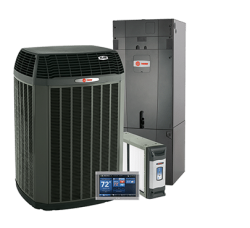 The most common heating and cooling system throughout the U.S. is a matched system with components designed to work together. Most often, this refers to the inside and outside central air conditioning components being matched. This is essential for efficient operation and the comfort level in your home.
The most common heating and cooling system throughout the U.S. is a matched system with components designed to work together. Most often, this refers to the inside and outside central air conditioning components being matched. This is essential for efficient operation and the comfort level in your home.
For example, the inside and outside components must use the same type of refrigerant to be able to work together. The coils, blower, and air handler must be compatible. Importantly, mixing mismatched equipment will usually void the warranty on the new HVAC equipment.
You’ll also hear the term “matched system” used regarding heating and cooling equipment that is designed to work together (covered below). Whether the air conditioning and heating equipment is matched or not, they share the same HVAC vents, ductwork, air handler, and blower fan. A mismatch here can cause problems, too.
Regardless of the central HVAC system design, they operate pretty much the same way. This page explains other configurations for central air conditioning installations.
How Does a Central Heating and Cooling System Work?
The thermostat monitors indoor temperature and sends commands to the HVAC system, to the air conditioner in hot weather and the furnace when it’s cooler outside.
Air Conditioner
The most common type of air conditioning equipment is a “split” system powered by electricity. It’s called split because the evaporator coil, air handler, and blower are inside the home while the condenser and compressor are outside.
A good central heating and cooling system is essential to your family’s comfort and safety. It’s also a significant investment that can improve the value of your home.
When the air conditioner kicks on, the cold, liquid refrigerant absorbs heat in the evaporator coil, located in or next to the air handler. It absorbs so much heat that it expands to a gaseous form.
This illustration from airconditionerlab.com shows how the refrigerant travels to the outside unit as a gas, forced through the copper tubing by the compressor, which is a pump for the refrigerant.
When the refrigerant reaches the outside unit, the compressor converts it back to liquid form and sends it to the condenser, which dissipates the heat. Pressures in the refrigerant lines may run from slightly under 100 pounds per square inch to more than 400 PSI.
As the condenser fan blows the heat away from the house into the outside air, the cooled liquid refrigerant then passes through the copper tubing back to the evaporator. The compressor converts the liquid back to an extremely cold gas as it enters the evaporator, and the cooling cycle is repeated.
Humidity from the air collects on the evaporator coils and drips down into a collection tray. The water is carried away through typing that connects to a drainpipe or floor drain in the home’s plumbing system. NOTE: if the drain tube gets blocked by algae or debris, the pan can overflow and cause serious water damage.
As the heat is removed from the air in the evaporator the blower fan pushes it through the ductwork to the vents in rooms throughout the house. Air return vents (the bigger vents) move the air back to the inside AC unit, passing it through a filter next to the air handler that removes dust and other allergens before sending it through the house again.
Furnace
In warmer climates, such as North Texas, we focus on the air conditioning because we use it more than half the year. (Instead of talking about heating and cooling systems, many people here just say “air conditioning.”) Even in this climate temperatures frequently dip into the 40s and 50s, and sometimes into the 20-40-degree range. Utility bills for many residents are about the same for heating and cooling their homes.
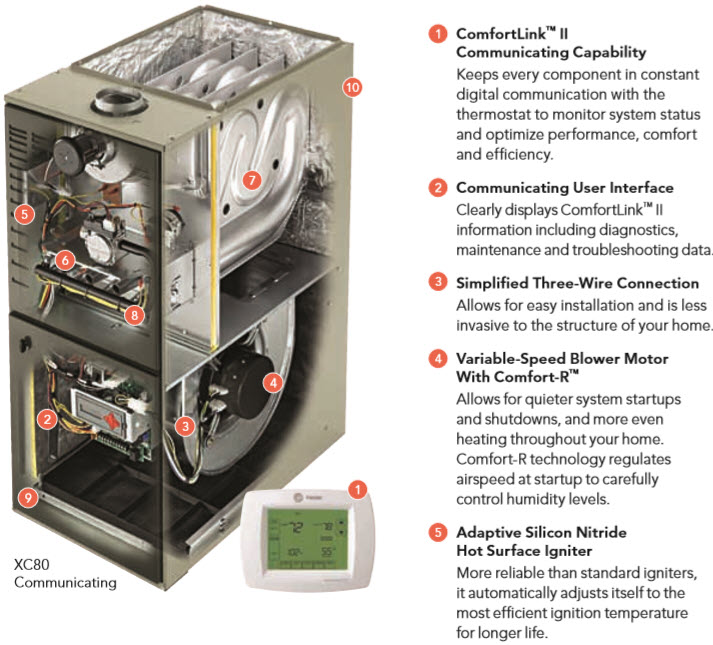
In cooler weather, the furnace adds heat to the air using natural gas or electricity. Because of the abundance and lower cost of natural gas, the majority of homes in the U.S. heat with it. If natural gas is not available electricity and propane are popular alternatives.
Unlike the air conditioning equipment, the heating equipment is all inside the house when you have a split-system central air conditioner, shown in this TRANE illustration. With this type of heating and cooling system, the air handler for the furnace also serves as the air handler for the AC unit.
Heating sequence – When the thermostat signals the furnace that heat is needed, the gas valve allows natural gas into the combustion chamber, where it is ignited, either by an electric ignitor or pilot light (newer systems have ignitors. Electricity runs through the ignitor making it glow red hot, which ignites the gas.
As the combustion chamber heats up, so does the fan limit control, a sensor that turns the blower fan on and off based on the temperature in the combustion chamber. The blower pushes warm air through the delivery ducts to the room vents and the air return vents route it back to the air handler, through the filter or other air filtration system.
SAFETY NOTE – While A/C refrigerant leaks are a concern and require the help of a professional air conditioner repair technician, they rarely pose a safety risk. Gas furnaces have inherent safety issues that must be evaluated at least annually during your fall heater tune-up. Gas leak detection and repair is very serious and must be performed by a licensed plumber.
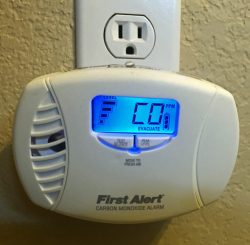 The combustion of natural gas or propane produces waste gasses, including carbon monoxide. When properly installed, the gasses travel to the roof through the exhaust vent where they are released into the atmosphere.
The combustion of natural gas or propane produces waste gasses, including carbon monoxide. When properly installed, the gasses travel to the roof through the exhaust vent where they are released into the atmosphere.
Carbon monoxide (CO) can be fatal. It is colorless, odorless and tasteless. The best way to check for CO is with carbon monoxide detectors. When tuning up your furnace professional HVAC technicians should check for:
- Cracks in the heat exchanger that can let CO into the air handler and the duct system;
- Incorrect air/gas mixture, which results in incomplete combustion, and
- Improper installation, including bad venting that can allow air to enter the burner from the wrong direction
Air Circulation System
Air flow is everything. If the airflow is not right, you will feel it, smell it, and pay higher utility bills. Air circulates throughout your home by natural ventilation (doors and windows opening and closing, air leaking around windows) and mechanical, via the ducts and vents in your HVAC system.
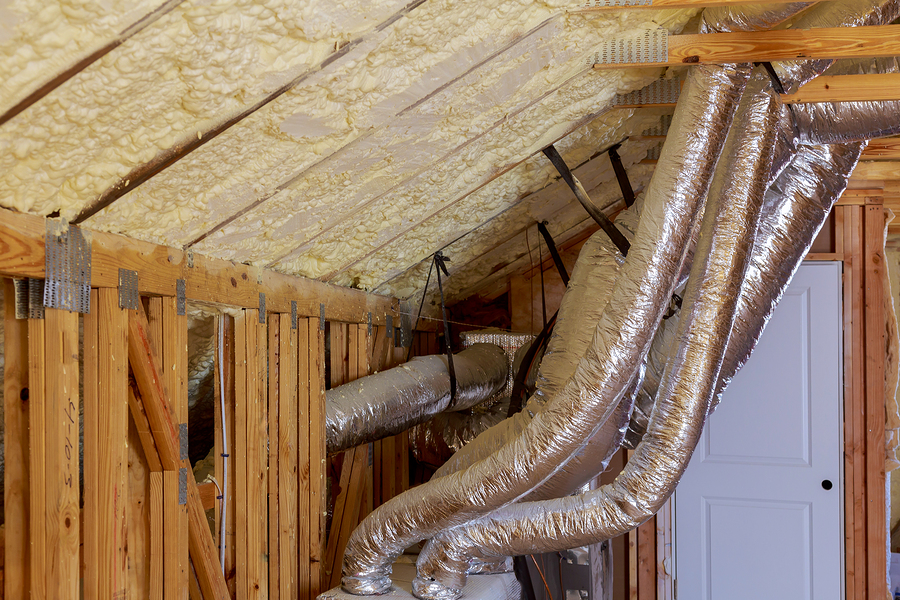
Air balancing is the process of ensuring the most even flow of cooled or heated air throughout your home’s HVAC system. Most homes have some degree of improper air balancing. This can reduce operating efficiencies as much as 30-to-50 percent.
Causes of bad airflow in central heating and cooling systems include improperly installed or mismatched equipment, including ductwork, an inadequate number or poor placement of vents (especially return vents), dirty air filters and ducts, poor duct sealing, rooms that let in a lot of direct sunlight and more.
Air balancing to maintain good airflow is just as important as which AC unit and furnace you install. Poor airflow results in:
- Uneven cooling and heating from room to room
- The HVAC system not being able to maintain steady temperatures
- Increased operating costs
- High indoor humidity levels, which can allow mold and mildew to form
- Poor indoor air quality, including unpleasant odors
Have professional HVAC technicians conduct an airflow analysis of your home’s heating and cooling system, point out any system limitations and recommend ways to improve airflow. There are some things you can do yourself, too:
- Close air delivery vents in rooms not in use
- Check air filters every 60-90 days and replace when dirty
- Avoid placing furniture where it blocks airflow
Thermostat
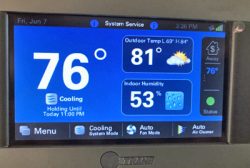 Your thermostat is Command Central for your home’s heating and cooling system. It measures the difference between your desired and actual room temperature and sends commands to the turn the system on or off. It should be placed in a central living area in your home, away from windows, doors and direct sunlight.
Your thermostat is Command Central for your home’s heating and cooling system. It measures the difference between your desired and actual room temperature and sends commands to the turn the system on or off. It should be placed in a central living area in your home, away from windows, doors and direct sunlight.
Older, mechanical thermostats have largely given way to digital thermostats that allow more precise settings. For a little more money, you can upgrade to a digital programmable thermostat – and you will get the price difference back faster than you might imagine.
The reason is you can program the thermostat to automatically change temperatures to account for day and night and times you are away from home. For even more convenience, a WiFi programmable thermostat (smart thermostat) will let you control your home’s HVAC system from anywhere you have an internet connection – especially handy when you’re out of town and want to monitor the system.
CONCLUSION
Central heating and cooling systems are vital to your family’s comfort and safety, so it’s important to understand how they work and what you can do to get the best performance from them. Basic components include:
- Air Conditioner – compressor and condenser unit outside working with the evaporator, air handler, ductwork and blower fan inside, plus the refrigerant and tubing.
- Furnace/Heater – includes the electric heating element or the gas burner and ignitor or pilot light, plus the manifold that connects it to the gas valve and the heat exchanger.
- Air Circulation System – includes the ductwork, the air handler, and the blower fan. The air filter is placed where return air reenters the heat exchanger.
- Thermostat – located in the living area, it regulates the temperature according to your settings.
Make it a point to have an HVAC maintenance plan, that includes spring AC tune-ups and fall furnace tune-ups by a professional HVAC technician. Check out billyGO NOW! for your annual tuneup and discounts.
